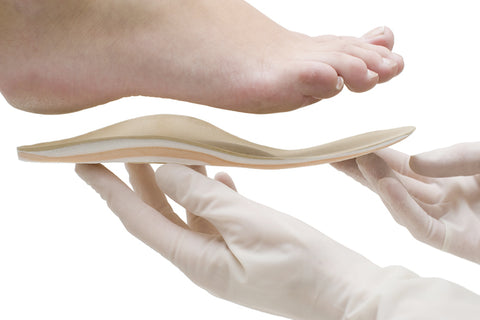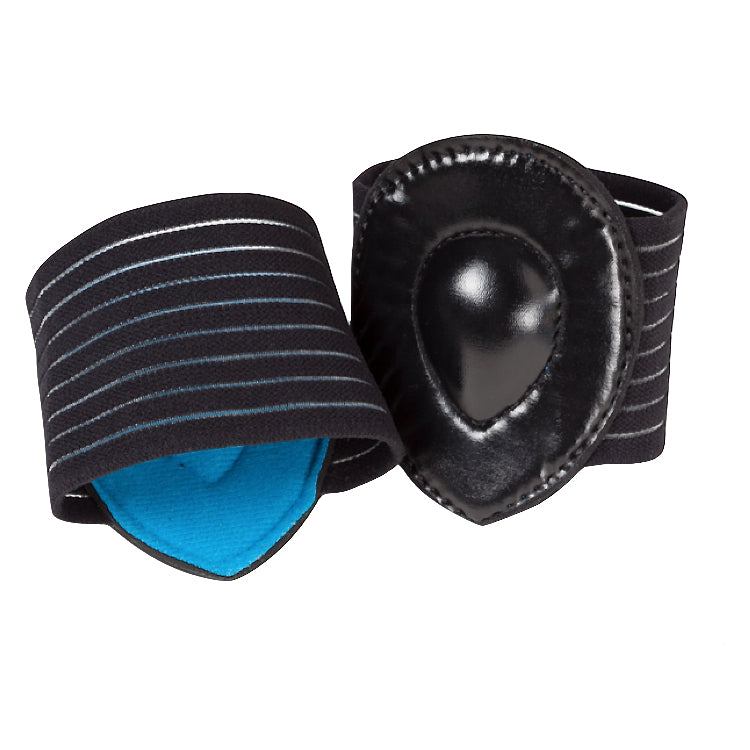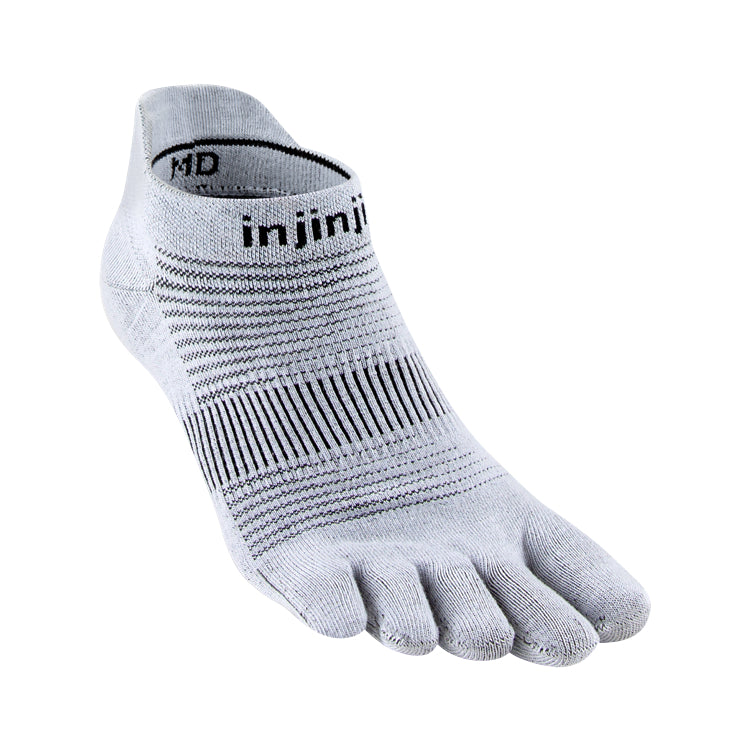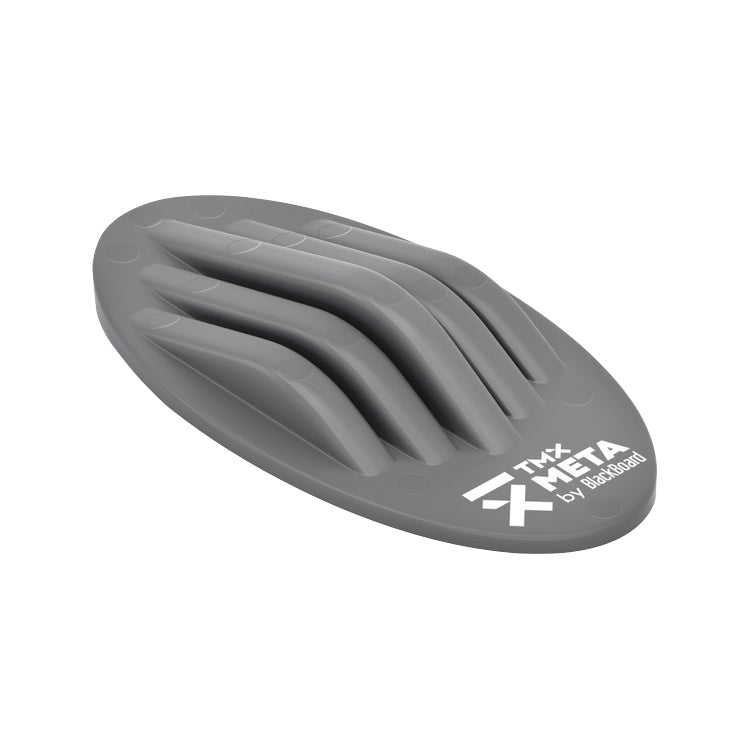Correct Toes & Orthotics
 Correct Toes eliminates the need for conventional orthotics in most people by enabling the foot arch (i.e., the medial longitudinal arch) to support itself. In general, we DO NOT recommend wearing Correct Toes in combination with orthotics; we instead recommend weaning yourself off orthotics—slowly and progressively—when introducing Correct Toes. Correct Toes toe spacers are, by definition, an orthotic, though conventional custom orthotics are placed under your foot arch (instead of...
Read more
Correct Toes eliminates the need for conventional orthotics in most people by enabling the foot arch (i.e., the medial longitudinal arch) to support itself. In general, we DO NOT recommend wearing Correct Toes in combination with orthotics; we instead recommend weaning yourself off orthotics—slowly and progressively—when introducing Correct Toes. Correct Toes toe spacers are, by definition, an orthotic, though conventional custom orthotics are placed under your foot arch (instead of...
Read more











Thank you very much for this excellent information. I have overpronation, hallux valgus, and fallen arches. Do you recommend using the Correct Toes together with my insoles and any additional support for the arch? And what kind of shoes? I thank you in advance for your reply. Congratulations on your work. Merveilleux!!!!
Hi, Mabel,
Thank you for your message. Please visit our Correct Toes and Orthotics page (www.naturalfootgear.com/blogs/education/17861564-correct-toes-orthotics) for more information about this product combination. You may also appreciate this page (www.naturalfootgear.com/blogs/education/17888744-natural-arch-support), which discusses natural arch support.
An additional helpful product may be a metatarsal pad, either from Pedag (www.naturalfootgear.com/products/pedag-metatarsal-pads) or Strutz (www.naturalfootgear.com/collections/strutz-foot-pads). A metatarsal pad can help restore proper balance between the toe flexor and extensor tendons, promote proper forefoot fat pad positioning (to protect the heads of the metatarsal bones), spread the transverse foot arch, and prevent pain in the ball of the foot. Because the products we sell work best within flat-soled shoes with wide toe boxes, any of the brands we sell may be helpful for you, as each meets those criteria.
If you have any additional questions, please do send them our way.
Kind Regards,
Andrew Potter
Is this Dr. Local? I have been wearing my Correct Toes with my orthotics; I think that is wrong.
Greetings, Rhonda,
Thank you for your message. Please check out this page (www.nwfootankle.com/resources/122-healthcare-providers) to find a natural foot health practitioner in your area. Dr. Ray McClanahan, who is featured in this video, practices natural sports podiatry in Portland, OR. Please do visit our Correct Toes and Orthotics page (www.naturalfootgear.com/blogs/education/17861564-correct-toes-orthotics) for more information about this specific product combination.
Best,
Marty Hughes, DC
This wasn’t clear for me until the very end, when he said ‘people who have their big toe in the correct position and still have completely flat feet may need a traditional orthotic’. That describes me; traditional orthotics (in conjunction with otherwise zero drop & wide toe box shoes) have so far been essential for me. However, I don’t have the conditions he was describing in the main body of the video, so far as I can tell.
Hello, Graeme,
Thank you for your post and for following through to the end of the video to discover the fullness of Dr. Ray’s message. Each human body varies just enough to make each of us unique, and we hope you garnered enough information to prompt your curiosity regarding what options exist for you to continue on your path to your healthiest feet!
Kind regards,
Sarah K. Schuetz
After having foot pain and stiffness for close to a year, I started wearing wide toe box shoes, going barefoot, and using Correct Toes. It has taken another year to get to a point where I can say I’m “cured.” I also did “Essentrics” with Miranda Esmonde White’s videos. She has exercises that stretch and strengthen the muscles that connect to the feet, and I truly believe they are helpful. My feet feel pain-free and strong, and even my knees don’t hurt! I now walk my dog and golf without a cart. After wearing “increased stability and anti-pronation” running shoes for work and leisure activities, wearing my first pair of Lems shoes felt so liberating!!!
Hi, Janet,
Thank you so much for your comment. We love hearing about how natural approaches to foot health have helped people so significantly. Please do keep us updated on your progress!
We’re here to assist however we can, so please don’t hesitate in reaching out should any questions ever arise.
All the best!
Andrew Potter
I am a ski coach for the Aspen Ski School. I just retired after 56 years of coaching. I have Correct Toes, but I can’t wear them in my Lange boots. Langes are the only boot that fit my narrow heel. I need to have ski orthotics made for my boots, as I cannot edge due to severe inward knee collapse. Ski orthotics correct this, which allows me to make and hold an edge. My question is, do you make anything for ski boots that corrects this problem? If you do not, are ski orthotics okay? They are made with the wearer in a weight-bearing mode, with knees slightly flexed. They go from toes to heel with the inside of the orthotic being raised for edge control and not allowing the knee to collapse inward while trying to edge skis. They go inside the ski boot, with the boot liner removed.
Hi, Lavelle,
Thank you for your comment. We ourselves do not make anything for ski boots that correct the problem you’re describing, and, in terms of whether or not ski orthotics are okay, I’m going to have to defer to your foot care specialist and what he or she feels is best for your care. Apologies that I couldn’t be more helpful here!
Kind regards,
Marty Hughes, DC
Just wondering if there is any information on Morton’s toe (where the great toe is shorter than the second metatarsal)?
Hi, Janet,
Thank you for your question. I recommend that you check out this article we put together on this very topic:
www.naturalfootgear.com/blogs/popular-q-a/why-do-some-people-have-a-longer-second-toe-than-big-toe
If you have any additional questions after reading this article, please don’t hesitate to reach out to us!
Kind regards,
Marty Hughes, DC
Hi. Do you have a UK website that I can order Correct Toes from? I have bunions on both of my feet from ill-fitting shoes … so I would really love to correct this problem without surgery. Thank you.
Greetings, Sonia,
Thank you for writing in. I’m sorry to hear about your bunions! To answer your question: Our company is based in the US, and so we don’t have a UK-based option for you at this time. We do, however, ship to the UK on a regular basis, and we would be happy to mail a pair of Correct Toes directly to you in the UK. You can select your desired Correct Toes color here:
www.naturalfootgear.com/collections/correct-toes
Please let us know if there is anything else we can do to assist!
Kind regards,
Marty Hughes, DC
Do I need to wear a larger size shoe in order for Correct Toes to feel comfortable? I have tried to wear the spacers with my existing shoes and can’t seem to find a comfortable fit.
Hi, Cherie. Thank you for your comment and question. This topic is vitally important because comfort is key when it comes to getting the most out of your set of Correct Toes. To directly answer your question, it may indeed be possible that you need to wear a larger size shoe in order to best accommodate Correct Toes, especially if you’re hoping to combine the spacers with a wider toe box shoe that has a more conventionally shaped toe box. The truth is, though, that pretty much any shoe that possesses a tapering toe box is simply not compatible with the Correct Toes appliance. Indeed, it’s usually antithetical, and it can be counterproductive to try to make the device fit the shoe. It would be better, we feel, to make the shoe fit the device.
Thankfully, there are now many Correct Toes-compatible footwear options for men and women:
• Men’s Foot-Healthy Shoes: www.naturalfootgear.com/collections/mens-shoes
• Women’s Foot-Healthy Shoes: www.naturalfootgear.com/collections/womens-shoes
Shoes such as these permit plenty of wiggle room for your toes in the toe box and incorporate a number of other beneficial design features, including a flat and flexible sole, a low overall stack height, and a lightweight design, that let your foot function as nature intended. And they won’t encroach on your toes (with spacers on) the way that most conventional shoes do. Depending on your particular situation and the specific shoe model you’re referencing, though, there may be more considerations here. If you’re close to achieving a good fit with your existing pair of shoes, there are a few strategies you can employ that could make the difference in terms of comfort. We explore a number of these strategies in our article entitled What if My New Shoes Aren’t Correct Toes Compatible?, which we encourage you to check out here:
www.naturalfootgear.com/blogs/popular-q-a/what-if-my-new-shoes-aren-t-correct-toes-compatible
We hope this answer helps! If you have any follow-up questions, please don’t hesitate to let us know; we’re happy to assist however we can.
Yours in Foot Health,
Drs. Marty & Robyn Hughes
I have not seen anything that gives an idea about what size of Correct Toes is recommended for men or women or for a given foot or shoe size. I wear a women’s US size 8 shoe, and I’m hoping you can help me determine the best size of Correct Toes.
Thank you for your question, Susan! It’s important to get the best possible fit with Correct Toes, as this will shape your experience with the device and how effective it is in helping you achieve your foot health goals. Fortunately, determining the best possible size of Correct Toes is usually pretty straightforward. Correct Toes is designed for all sets of feet, so there is no men’s- or women’s-specific version of the device. There are just four sizes in total (X-Small, Small, Medium, and Large) that you can choose from (and then customize from there, if need be). Here is a chart (which you will also find under the “Sizing” tab on our Correct Toes product pages) that will help guide you in selecting your ideal size:
https://cdn.shopify.com/s/files/1/0735/7693/files/Correct_Toes_Sizing_Chart_0d24bab5-9179-4f87-9ba8-79c429ce625f.jpg?v=1702321273
As indicated by the chart, you’ll want to use your shoe size to determine your Correct Toes size. As a general rule, if you happen to be on the cusp between two sizes, consider ordering the larger of the two if your toes are relatively wide, or the smaller of the two if your toes are relatively narrow. You can also order both sizes, compare them side by side, and then return the size that doesn’t fit as well for a refund. If you normally wear a women’s US size 8 shoe, as you mentioned above, then you will most likely do best with the “Small” size of Correct Toes.
We hope this info helps! If you or anyone reading this has follow-up questions about Correct Toes sizing, please don’t hesitate to reach out!
Yours in Foot Health,
Drs. Marty & Robyn Hughes
Great video! Sold me on Correct Toes. I’m curious, though: What brand of shoes is Dr. Ray McClanahan wearing in this video? Thank you.
Hi, Gary,
Thank you for your comment. I’m not 100 percent sure, but it looks like that’s an early Topo Athletic model.
All the best,
Marty Hughes, DC